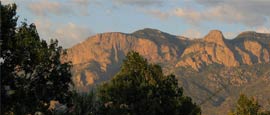Albuquerque History
Native American groups first inhabited the region 2,000 years BC. The Spanish arrived in the 1500s but it was another 200 years, in 1706, that a settlement was founded on the banks of the Rio Grande.
The site developed as an agrarian outpost but thanks to its location, it also provided protection from, and trade with, the Indians in the area. The colony’s Spanish Governor, Francisco Cuervo y Valdez, wrote to the Duke of Alburquerque back in Spain to report their newly founded town, which was subsequently named after the duke. Over time, the first “r” was dropped, leaving Albuquerque spelled as it is today.
Albuquerque grew in prominence as an important stop on the Camino Real, a vital trade route from Chihuahua to Santa Fe. By 1821, Mexico had gained independence from Spain and trade with the United States grew. The famous Santa Fe Trail, which led from Missouri to Santa Fe, connected with the Camino Real into Albuquerque. As commerce grew, so did the population.
The construction of Albuquerque’s railroad terminal in 1880 helped the city’s trade and population to boom further. In fact, Anglo settlers began moving to Albuquerque en masse, transforming the ethnic and geographic structure of the city. The main commercial centre moved downtown and the Old Town fell in prominence. By 1891, Albuquerque was incorporated as a city.
Historic Route 66, which became a famous automobile road in the 1920s, weaved through Albuquerque, helping new motels, restaurants and gift shops to flourish and attracting tourists.
In 1928, Albuquerque gained its first airport, and within 20 years was propelled into the high-tech era when Kirtland Air Force Base was established in 1940.
The following decades saw key developments: the Sandia Peak Tramway, the longest of its kind in North America, opened in 1966 and in the 1970s, Bill Gates set up Microsoft in Albuquerque. But the 1990s brought decline to the downtown area. It took another 20 years before the district was rejuvenated and in 2006, Albuquerque celebrated its Tricentennial.
Did you know?
• San Felipe de Neri Church dates back to 1793 and is one of the oldest surviving buildings in the city.
• After the creation of the airport, celebrity fliers such as Charles Lindbergh, Laura Ingalls, Amelia Earhart and Roscoe Turner were attracted to the city.
•The city's famous balloon fiesta has its roots more than a century earlier when a local bartender piloted a "gas bag" from the centre of town up to nearly 14,000ft before it landed, intact, a few miles away.
Do you have any Feedback about this page?
© 2025 Columbus Travel Media Ltd. All rights reserved. No part of this site may be reproduced without our written permission, click here for information on Columbus Content Solutions.




 You know where
You know where